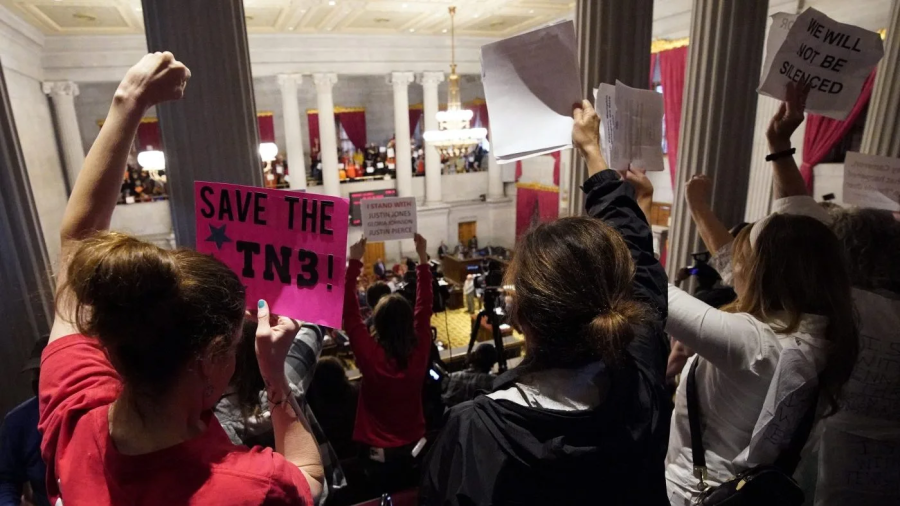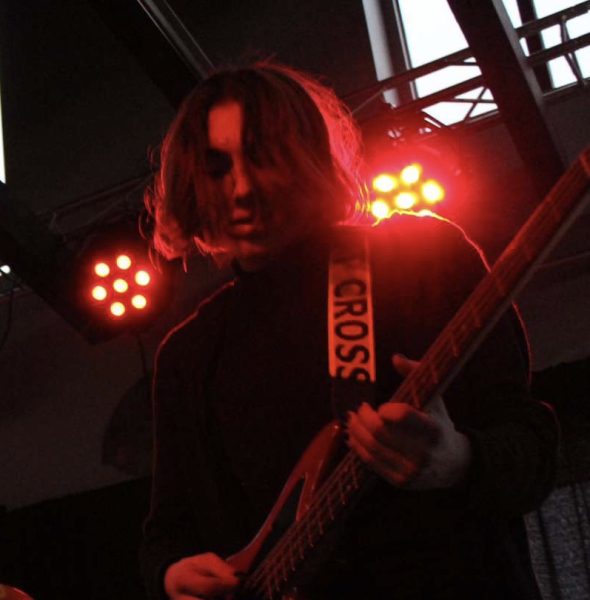Thoughts and Prayers: A Cohesive Guide on How To Destroy America
May 17, 2023
On April 20th, 1999, the whole U.S. was shaken. Two Columbine High School students, Dylan Lebold, and Eric Harris, went into their school — planted bombs that did not go off, and shot and killed 15 people (including themselves) and 28 injured. At the time, this national tragedy was a one-of-a-kind thing and it conspired at a school where no one could “believe something like this would happen”. There was a prime belief present amongst society that nothing like this would happen ever again, but that wasn’t the case, the epidemic of school warzones kept getting worse and worse.
Throughout the 2000s, 80 instances of school shootings occurred in America — with the most prominent being Virginia Tech in 2007. Thirty-two college students and faculty students were executed by a shooter — who then offed himself. This was, and still is, the most deaths from a school shooting in history. When Columbine occurred, debates on gun control sparked up and restrictions on weapons were discussed. However, debates on this subject concerning school shootings died down until Virginia Tech, which brought the debate back to the forefront of the news. In both of these instances, all that legislature could offer were two things: thoughts and prayers.
In light of these two major shootings, and the fifty-six shootings between each, a clear political divide became more apparent. While mourning parents of the victims had nightmares of their dead children with their skin ripped open by 44-millimeter ammo — republican legislators patched the still-warm bodies with constitution-themed band-aids mixed with thoughts and prayers, ignoring the blood seeping through. During a house meeting right after Virginia Tech, it took four speakers to finish talking until the name of the school was even brought up. According to Politico, the first four speakers “focused on taxes, with each side lamenting the other’s economic policies”. One day after Virginia Tech, George Bush took to a stand in an arena and gave a six-minute speech on the shooting with him repeating the same talking points echoed through any conversation post-shooting, stating the obvious fact that the victims “did nothing to deserve this fate… Wrong place at the wrong time…” And finally, “They [left] behind grieving families, and grieving classmates, and a grieving nation”. The government has put this concept into the minds of the youth that they’re at risk of getting shot in their school, where they should be safe, just because of bad luck and that the only response to their death will be a grieving nation but not a respondent government that cares about their corpse.
The theme of the U.S.’s constant cycle of shooting and then prayers and then forgetting about the shooting kept pushing forward without any changes or improvements in safety. Nothing helpful came out of the government until another high kill count happened. On December 14th, 2012, 20 children would say goodbye to their parents for the last time — before walking into their school, Sandy Hook Elementary, for what they thought would be a normal school day. The day would be set in stone as a tragic day at 9:35 AM when a shooter came into the school with a bushmaster. The shooter would go from class to class and systematically execute each student — in a classroom of fifteen, one little girl survived by playing dead while everyone around her died. When seeing her mother again, all that could escape her mouth was: “Mommy, I’m okay, but all my friends are dead”. When children were exiting their school, through the glass and blood-painted floors, they were told to “put their hands on the shoulders of the student in front of them and to close their eyes as they walked”, but most of them probably saw a glimpse of what was in that halls — a memory that sticks with them and will haunt them for the rest of their lives. 28 died, and 20 of the victims were elementary school children.
In response to the shooting, President Obama put a gun violence task force forward — fronted by future president, Joe Biden. Obama also made it very clear that gun control would be a center point in his next term — the closest we’ve gotten as a country to make an impact on the unending nature of school shootings. Many ideas were conceptualized in the wake of sandy hook:
- Background checks for assault rifles (the bill would never happen).
- A.L.I.C.E (Alert, Lockdown, Inform, Counter, Evacuate).
- A focus on mental health in the youth.
- Renewed conversations on gun control.
Background checks and gun control are hot topics in conversations about school shootings and gun violence — this is where politics becomes intertwined with the death of children. Half of American households have a gun in the house or a safe in another location, while half of the country does not. The people who own guns typically are the ones who do not support gun control — but they occasionally back background checks. On the other end, the people who do not own guns typically support both gun control and background checks — this is where the division in the U.S. is made clear and why neither bill has been passed.
Out of a sample size of 100, 18 Republicans said that gun violence is a very big problem — with 40 thinking it is a small problem. On the other end, 73 democrats said that it is a very big problem and 20 believe it is a small problem. 53% of Americans also support stricter gun laws, with Democrats typically skewing toward gun control and Republicans skewing towards the complete opposite.
Gun violence, in general, is a very class-based situation — and is more likely to appear in the lower class. However, school shootings are an outlier with shooters typically being middle class and having legal ownership of guns. School shootings aren’t a class issue and that’s what makes solving them difficult without implementing gun control or background checks. To effectively lower school shooting rates without incorporating either of these concepts, a government would have to fund mental health resources, get better security in schools, and attack the problem at the root cause. The issue is that no one knows the real reason for school shootings, because there is not one constant cause. The thought of it is nihilistic, but as long as the government does not do anything about shootings or gun laws — children will keep dying in their schools as they’ve been since the 90s. The concept: “If you take away easy access to guns, then fewer shootings will happen” seems almost too much of a solution to pass up, it’s an easy fix, so why hasn’t this happened?
The restriction of guns has been an idea that has slowly come into fruition since Franklin D Roosevelt was in office, with the president putting in an NFA tax that taxed the manufacturing of assault weapons to prevent organized crime gang wars. In 1939, sawed-off shotguns were labeled illegal under the second amendment — since they would not help a militia. In 1968, in the wake of Kennedy’s death, Lyndon Johnson put the first gun control act into place. This made the sale of handguns restricted to anyone below 21, prohibited felons and the mentally ill from buying weapons, and implemented serial codes on firearms. Bill Clinton would eventually pass an anti-assault weapons act in 1995 after a string of shootings, however, this would be one of the last real anti-gun acts and would expire in 2004 after its ten-year period and every new concept for anti-gun laws would become only a proposition. If anything, laws started benefiting gun companies: with the Tiahrt Amendment in 2003 prohibiting suing a gun company over a death caused by a criminal with one of their guns.
Over time, death via guns has fluctuated. The lowest it had been since the 60s was 1968 (9425 deaths), with it increasing until the 90s — before dropping from ‘94 – ‘04 during the assault weapons ban. It would fluctuate up and down till 2019 and then it would consistently rise, leaving a trail of bodies behind. There were 20,958 gun-related murders in 2021. Despite this apparent increase in recent years, the government has done nothing — because they are in a constant stalemate.
State and federal politicians care more about their political party than your safety in schools. While children learn how to follow evacuation and shooting drills (Quakertown Community High School is one of the many schools that use A.L.I.C.E, which is ineffective as a concept — shooters typically have a link to the school and will know where evacuation points are. ALICE practically herds victims to a shooter and there is little evidence it even works. Students are more likely to survive if they independently research how to survive a shooting and how to pack their bag to the point where it can act as a bulletproof vest.) politicians debate in their marble buildings and courtrooms about the constitutionality of gun control and the economics — because your life is less important than money and politics to them.
The problem isn’t protesting or public outcry. Public outcry is ignored and punished by local governments. After the Tennessee shooting in April of 2023, crowds of youth and adults alike marched to the house and displayed haunting scenes of playing dead and screaming at the politicians about how they are dying in schools and how they are afraid to attend school. In response to the protest, three house members stood up and joined the protesters — leading to two out of the three of them being expelled from the house.
If the issue of shootings stays in a political stalemate, it will never end. Originally, to end this article, I was going to list the names of every single death in a mass shooting this year — but there have been more mass shootings than days so far this year (Jan 1 – May 11, 2023), with 208 mass shootings have taken place this year. The only way for this to end is to contact your local representatives, show your outrage, and demonstrate your fear to the government. No child should be killed where they should be learning — Governmental ignorance has effectively made the whole U.S. flag red, bleeding over all the stars and stripes.




